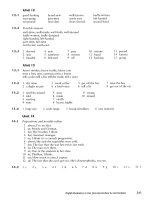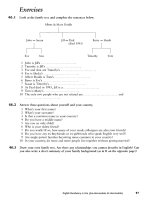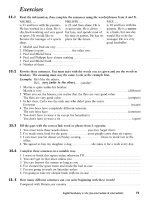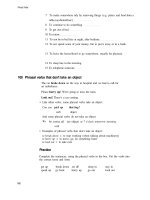Pair work 1 Elementary Pre Intermediate phần 9 potx
Bạn đang xem bản rút gọn của tài liệu. Xem và tải ngay bản đầy đủ của tài liệu tại đây (477.15 KB, 10 trang )
30
Photographs
,
Student
A
Look at these photographs. Your partner also has photographs but there are ten
differences. Work with your partner to find all the differences.
Talk to your partner. Say:
I
have a photo of
Do you?
I
don't have a photo of
In my photo, there's a
In my photo, there isn't
a/an
In my photo there are
and
In my photo there aren't any
Make a list of all the differences you find.
born
Pair Work Book
1
@
Penguin
Books
2002
30
Photographs
Student
B
Look at these photographs. Your partner also has photographs but there are ten
differences. Work with your partner to find all the differences.
Talk to your partner. Say:
I
have a photo of
Do you?
I
don't have a photo of
In my photo, there's a,
In my photo, there isn't a/an
In my photo there are
and
In my photo there aren't any
Make a list of all the differences you find.
From
Pair Work Book
I
a
Penguin
Books
2002
31
Who's who?
Student
A
E?
Here are six people plus some information about them.
Peter is
a
year older than
Sally.
Julie
and
Sally
are both thinner than
Mary.
John is twenty-one next birthday. The tallest person is
a
year younger than John.
Julie is the oldest
-
she is seven years older than
Mary.
b
L
2
Your partner also has information about the six people. Work together to see if you
4
I
-
can work out their names and ages.
(Write them
in
the boxes.)
9
You are allowed to read out the information you have about the six people but you
&
must not let your partner see your page.
&%
m m-m-m m m-M "
L
31
Who's who?
Student
B
r?
Here are six people plus some information about them.
r4!
Sally
is the youngest. Peter is taller than
Mary
but shorter than Mike.
Julie is standing between Peter
and
Sally.
Sally
is wearing
an
earring.
The thinnest person is
only
16.
L
C
Your partner also has information about the six people. Work together to see if you
can work out their names and ages.
(Write them
in
the boxes.)
You are allowed to read out the information you have about the six people but you
F
must not let your partner see your page.
From
Pair Work Book
1
@
Penguin
Books
2002
83
32
Find the differences
Student
A
1
I
Look carefully at this picture of people on a plane. Your partner also has a picture
but there are twelve differences. Talk together to find the differences and note
I
them down. Do not let your partner see your picture.
I
I
32
Find the differences
Student
B
Look carefully at this picture of people on a plane. Your partner also has a picture
but there are twelve differences. Talk together to find the differences and note
I
them down. Do not let your partner see your picture.
84
From
Pair Work Book
1
@
Penguin
Books
2002
33
A
family
tree
Student
A
Here is a drawing of a family tree. Your partner also has a drawing of a family tree
but it is not exactly the same as yours.
(There are twelve differences.)
By asking your
partner questions, see
if
you can find the differences, and put a circle around them.
Before you start, work our the sort of questions to ask. For example:
Who is Bob married to?
OR
Is Bob's wife Alice?
What does Paul do?
OR
Is Paul a teacher?
How many children have Have Colin and Jennifer
Colin and Jennifer got?
OR
got three children?
How
o1.d is Samantha?
OR
Is Samantha nineteen?
When you are both ready, take it in turns to ask and answer questions.
When you have finished, compare the family trees.
JONES
ALICE
Retired
7
2
a
hairdresser
19
PETER
PAMELA
a
schoolboy assistant
17
a
bank
clerk
a
12
24
20
university
student
20
Frh
Pair
Work Book
1
@
Penguin
Books
2002
33
A
family
tree
Student
B
Here is a drawing of a family tree. Your partner also has a drawing of a family tree
but it is not exactly the same as yours.
(There are twelve differences.)
By asking your'
partner questions, see if you can find the differences, and put a circle around them.
Before you start, work our the sort of questions to ask. For example:
Who is Mary married to?
OR
Is Mary's husband called Paul?
What does Samantha do?
OR
Is Samantha a hairdresser?
How many children have Have Brian and Ann
Brian and Ann got?
OR
got one child?
How old is Alice?
OR
Is Alice seventy-two?
When you are both ready, take it in turns to ask and answer questions.
When you have finished, compare the family trees.
JONES
a
hairdresser
2
o
JAMES
PAMELA
a
schoolboy
24
a
bank
clerk
a
shop
20
assistant
12
20
From
Pair Work Book
1
@
Penguin
Books
2002
L
C
F
34 Buying
a
shirt
Student
A
L
The following sentences are part of a dialogue between a shop assistant and a
customer. Unfortunately, you have only got the customer's words. Your partner has
the shop
assistant's.
y'
Working together, try to put the complete dialogue in order. You must not show
your part to your partner, but you can read out the sentences. Together, mark the
dialogue
1-19.
(Your part
will
be marked
2, 4, 6, 8, 10, 12, 14, 16
and
18.)
r?
When you have finished, check by reading it aloud. To help you, the last part of
your dialogue is marked.
Before your start, read through the sentences.
I
don't think
SO
too dark.
-~-m ~ ~ m-~ ~ ~ ~ ~-~ ~-"~ ~~~~~-~-m~ ~~~ ~~~-~~
P
+
34 Buying
a
shirt
Student
B
I-
The following sentences are part of a dialogue between a shop assistant and a
i?
customer. Unfortunately, you have only got the customer's words. Your partner has
$
the shop assistant's.
L
+!3
Working together, try to put the complete dialogue in order. You must not show
-
your part to your partner, but you can read out the sentences. Together, mark the
-%
dialogue
1-19.
(Your part
will
be marked
1, 3,
5,
7, 9,
11,
13, 15, 17
and
19.)
x
When you have finished, check by reading it aloud. To help you, the first part of
-
-
your dialogue is marked.
z
Before your start, read through the sentences.
t-
4
only two kinds of blue
z
you Like?
G
(~ut
itf
very
Blue.
I
see. And
this one
-
it
has blue and
about this one?
Fralh
Pair
Work Book
I
@
Penguin
Books
2002
35 The secret word
Student
A
What are these ten words? Your partner has the answer and will explain them to
you. You can ask:
What's word n~~mber
?
If
you think you know, write it down. But don't say the word!
Now it is your turn to explain words to your partner.
Before you start, think about what you are going to say.
For example:
number
1
(jeans
)
You wear them and they are usually blue.
etc.
1
jeans
2
tomorrow
3
garden
4
white
5
burger
6
train
7
cinema
8
married
9
picture
10
telephone
When you have both finished, check your answers.
m-~~~ m~-~ m-m-m~-m~~ ~ ~-m ~~~ m
35 The secret word
Student
B
Here are ten words for you to explain to your partner. Before you start, think about
what you are going to say. For example:
Number
1
(banana) It's a fruit. It's long and
yellow, etc.
1
banana
2
weekend
3
yesterday
4
teacher
5
computer
6
clock
7
sandwich
8
green
9
birthday
10
people
Now it is your turn to ask your partner to explain words to you.
You can ask:
What's word number
7
If
you think you know, write it down. But don't say the word!
1
6
When you have both finished, check your answers.
88
From
Poir
Work
Book
1
@
Penguin
Books
2002
36
Half
a
crossword: food and drink
Student
A
This crossword is only half finished. Your partner also has a crossword that is only
half finished. Take turns to ask each other about the words you do not have,
e.g.
What's
2
across?, What's
4
down?
Answer by giving an explanation of the word.
All the words are connected with food and drink.
Before you start, look at the words in your crossword and think of how you are
going to explain them.
1
milk
1
water
menu
You can ask your partner if you do not know how to spell a word.
When you have finished, look at each other's crosswords.
*
From
Pair Work Book
1
@
Penguin
Books
2002
36
Half
a
crossword: food and drink
Student
B
This crossword is only half finished. Your partner also has a crossword that is only
half finished. Take turns to ask each other about the words you do not have,
e.g.
What's
1
down?, What's
9
across?
Answer by giving an explanation of the word. All
the words are connected with food and drink.
Before you start, look at the words in your crossword and think of how you are
going to explain them.
You can ask your partner if you do not know how to spell a word.
When you have finished, look at each other's crosswords.
90
From
Pair
Work Book
I
@
Penguin
Books
2002









